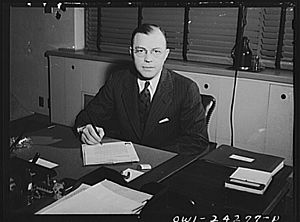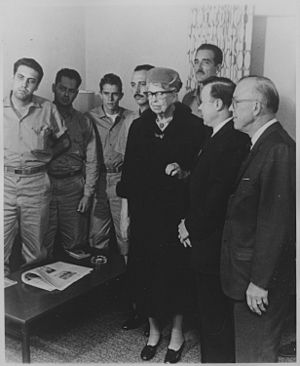Milton S. Eisenhower facts for kids
Quick facts for kids
Milton S. Eisenhower
|
|
|---|---|
 |
|
| 8th and 10th President of Johns Hopkins University | |
| In office 1971–1972 |
|
| Preceded by | Lincoln Gordon |
| Succeeded by | Steven Muller |
| In office 1956–1967 |
|
| Preceded by | Lowell Reed |
| Succeeded by | Lincoln Gordon |
| 11th President of Pennsylvania State University | |
| In office 1950–1956 |
|
| Preceded by | James Milholland (acting) |
| Succeeded by | Eric A. Walker |
| 9th President of Kansas State University | |
| In office 1943–1950 |
|
| Preceded by | Francis Farrell |
| Succeeded by | James McCain |
| Director of the War Relocation Authority | |
| In office March 18, 1942 – June 18, 1942 |
|
| Preceded by | Position created |
| Succeeded by | Dillon S. Myer |
| Personal details | |
| Born |
Milton Stover Eisenhower
September 15, 1899 Abilene, Kansas, U.S. |
| Died | May 2, 1985 (aged 85) Baltimore, Maryland, U.S. |
| Spouse |
Helen Eakin
(m. 1927; died 1954) |
| Children | Milton S. Eisenhower Jr. Ruth Eakin Eisenhower |
| Relatives | Dwight D. Eisenhower (brother) |
| Alma mater | Kansas State University (B.S.) |
Milton Stover Eisenhower (born September 15, 1899 – died May 2, 1985) was an important American leader in education. He was the president of three big universities: Kansas State University, Pennsylvania State University, and Johns Hopkins University. He was also the younger brother of U.S. President Dwight D. Eisenhower.
Contents
Milton Eisenhower's Early Life and Education
Milton Eisenhower was born in Abilene, Kansas. His parents were Ida Elizabeth Stover and David Jacob Eisenhower. His family was not wealthy.
He went to public schools as a child. In 1923, he graduated from Kansas State University. He earned a degree in industrial journalism.
Milton Eisenhower's Career Journey
Working for the U.S. Government
From 1928 to 1941, Milton Eisenhower worked for the U.S. Department of Agriculture. He was the Director of Information. In this role, he helped explain the government's "New Deal" programs.
Milton Eisenhower During World War II
In 1942, during World War II, Milton Eisenhower became the director of the War Relocation Authority. This agency was in charge of moving and housing Japanese Americans from their homes.
Eisenhower did not agree with this mass relocation. He tried to make things better for the people involved. He suggested letting women and children stay on the West Coast, but this idea was turned down.
As director, he worked to lessen the difficulties for Japanese Americans. He set up a council to get advice from Japanese Americans. He also created programs to help some Japanese Americans find jobs or continue their college education. He tried to protect their property, but these efforts were mostly unsuccessful.
He left this role after only three months. From June 1942 to mid-1943, he worked for the Office of War Information.
Leading Universities: A College Administrator
In May 1943, Eisenhower became the President of Kansas State University. This was his old college. He stayed in this job until 1950.
During this time, he also became the first chairman of the U.S. National Commission for UNESCO. UNESCO is a part of the United Nations that promotes education and culture. He worked to create similar commissions in each U.S. state. He also helped make Kansas State more open to African Americans. He pushed for sports teams to be racially integrated.
Milton Eisenhower was often called "Doctor." However, this was an honorary title, not a degree he earned.
After Kansas State, he led two more universities. He was president of Pennsylvania State University from 1950 to 1956. Then, he led Johns Hopkins University from 1956 to 1967. He returned to Johns Hopkins for a short time from 1971 to 1972.
At Johns Hopkins, the university grew a lot under his leadership. Its income and money for future projects greatly increased. Many new buildings were built, including the Milton S. Eisenhower Library. This library was named after him in 1965. Students and teachers respected him. He even held office hours where any student could visit him.
When he retired in 1967, he was given the title president emeritus. This means he was honored for his past service. In 1971, he came back to Johns Hopkins for ten months to help out. He worked to reduce the university's debt. He was known for being fair during this challenging time. He retired again in January 1972.
Milton Eisenhower's Political Involvement
Milton Eisenhower also advised three U.S. Presidents. He worked with his brother Dwight D. Eisenhower (1953–1961). He also advised John F. Kennedy (1961–1963) and Lyndon B. Johnson (1963–1969).
In 1968, President Johnson asked him to lead a group. This group studied the causes of violence in the country.

After the Bay of Pigs Invasion in 1961, President Kennedy asked Eisenhower to help. He worked with Eleanor Roosevelt and labor leader Walter Reuther. Their job was to negotiate the release of American prisoners in Cuba.
In 1980, Milton Eisenhower was a running mate for John B. Anderson. Anderson was an independent candidate for President of the United States.
Milton Eisenhower's Personal Life
Milton Eisenhower married Helen Elsie Eakin in 1927. They had two children: a son, Milton Stover Eisenhower, Jr., and a daughter, Ruth Eakin Eisenhower. Helen passed away in 1954.
When he was in college, he was a member of the Sigma Alpha Epsilon fraternity.
Milton Eisenhower passed away from cancer in Baltimore, Maryland, on May 2, 1985.
Milton Eisenhower's Legacy
Many places and programs are named after Milton S. Eisenhower:
- The Milton S. Eisenhower Library at Johns Hopkins University. It opened in 1964 and holds millions of books. It is mostly underground because of the way the land slopes.
- The main research building at the Johns Hopkins University Applied Physics Laboratory was once named the Milton S. Eisenhower Research Center.
- The Milton S. Eisenhower Auditorium at Penn State University. This is a large center for performing arts. It opened in 1974.
- Eisenhower Chapel, also at Penn State, is named after his wife, Helen Eakin Eisenhower.
- Eisenhower Hall at Kansas State University. It opened in 1951. It houses offices for the College of Arts and Sciences.
- The Milton S. Eisenhower Symposium is a lecture series at Johns Hopkins University. Students organize it, and the events are free for the public.

